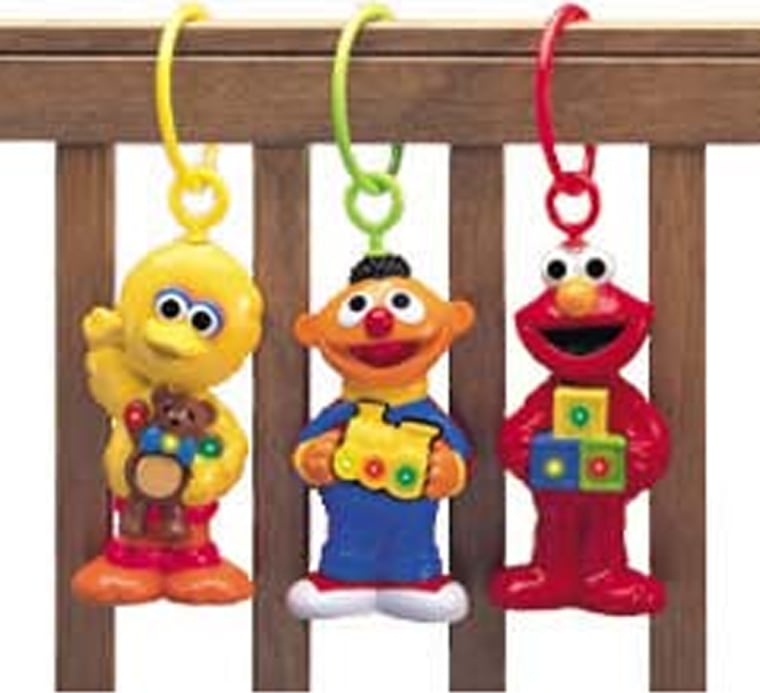There’s trouble in Toyland. Two huge recalls — both involving toys made in China with lead paint — have many parents worried about the safety of the toys they buy. The truth is, they should be concerned.
Unsafe toys have been imported from China for years. But when 1.5 million Thomas & Friends wooden trains and accessories are recalled because of lead paint and a million Fisher-Price toys — including Big Bird, Elmo, and Dora the Explorer — are recalled for the same reason, the problem becomes front page news.
“This is an industry that really needs to get back to quality control and understand the dangers of lead in their products,” says Scott Wolfson, a spokesman for the U.S. Consumer Product Safety Commission.
Children are especially susceptible to lead. Even at low levels it can cause learning disabilities and behavior problems. “These children can lose IQ points,” says Dr. James Roberts, a pediatrician at Medical University of South Carolina. “They can also have attention problems.”
That’s why it’s illegal to use any lead paint on toys sold in this country. The major toy manufactures who have their products made in China specify that lead-free paint is used. But lead paint is still widely available in China and as we’ve seen, Chinese factories sometimes cheat. Using lead paint saves money because it dries faster, which speeds up production. Lead also makes the paint last longer.
Just trying to keep the customer satisfied
Most toys sold in American stores — probably 70 to 80 percent — are now made in China, a country that has been in the news a lot lately because of hazardous products.
Toy companies went to China in order to lower production costs. It was the easiest way to deal with the constant pressure from retailers for lower prices to satisfy today’s bargain-conscious consumer.
By going overseas, American toymakers, “are just not as involved and responsible as they should be in terms of the safety of their products,” says Rachel Weintraub, Director of Product Safety for the Consumer Federation of America.
“There are huge lapses in American manufacturers taking responsibility for every step of their supply chain,” Weintraub says. “And these lapses are putting our children at risk.”
Recalls are no longer the answer
The major toy makers and retailers already have testing and inspection programs in place. In fact, it was in-house testing by Fisher-Price that detected the lead paint on the 83 toys recalled last week. Similar testing by RC2 found the lead paint on the Thomas & Friends toys.
Both companies have vowed to improve their inspection process. In a written statement to msnbc.com, RC2 says it is increasing the scope and frequency of testing for both materials and finished products. The statement says RC2 is now requiring test reports on every batch of paint.
The toy industry knows it has a problem and promises to fix it. Joan Lawrence, Vice President of Standards and Regulatory Affairs at the Toy Industry Association, tells me they are looking at various ways to beef up the safety system. “Some changes will be implemented very quickly and more will be in place by the holiday shopping season,” she says.
Most of the toys on the market are safe. Critics say that’s not good enough.
There have been 33 toy recalls so far this year. Every one of these hazardous toys was made in China.
Consumer groups want a comprehensive system that detects dangerous toys before they can come into the country. This would include:
The bottom line
You don’t have to be a brain surgeon to realize we’re got a problem here – lead paint on toys made in China. So let’s fix it. Until China proves it is capable of playing by the rules, we need to test and retest.
There must be a system created to catch dangerous products before they come into our homes. Parents cannot spot dangerous toys on the store shelf and they should not have to worry that a toy they give their child will poison them.
Congress, which has been slashing the CPSC's budget for years, needs to wake up and step up to the plate. The CPSC needs more money and more personnel to do the job the American public expects it to do.
A bill introduced last month by Sen. Dick Durbin (D-Ill) and Sen. Bill Nelson (D-Fla) would get things going in the right direction. It would require third party testing of all toys — imported and domestic — made for children age 5 and younger.
“How many more deadly toys do we have to recall before Washington responds?” Durbin said in a written statement. “American families should not be playing Chinese Roulette at the toy store.”
More information
